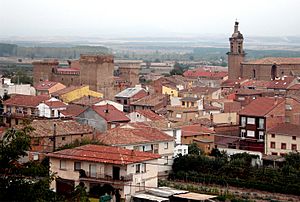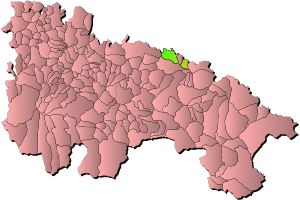Agoncillo, La Rioja facts for kids
Quick facts for kids
Agoncillo
|
||
|---|---|---|
 |
||
|
||

Location within La Rioja.
|
||
| Country | ||
| Autonomous community | ||
| Comarca | Logroño | |
| Area | ||
| • Total | 34.73 km2 (13.41 sq mi) | |
| Elevation | 346 m (1,135 ft) | |
| Population
(2018)
|
||
| • Total | 1,105 | |
| Demonym(s) | agoncillano/a or avionero/a | |
| Time zone | UTC+1 (CET) | |
| • Summer (DST) | UTC+2 (CET) | |
| Postal code |
26509
|
|
Agoncillo is a small town and a municipality located in the La Rioja region of northern Spain. It's a place with a long history, dating back to ancient times.
A local football team, Club Deportivo Agoncillo, is based here.
The name Agoncillo might come from an old Celtic settlement called Egon. Its ruins are thought to be near the modern town. The area was also settled during Ancient Roman times. Agoncillo is in a great spot near the Ebro River. This river used to be a border between the old kingdoms of Castile and Navarre. The town is also close to where the Jubera and Leza rivers meet, with the Leza River flowing into the Ebro nearby. This location helped Agoncillo control river crossings and an important road.
People believe the current town stands where the ancient settlement of Egón once was. This is why Agoncillo has its modern name. A Roman road passed nearby, which was also important in the Middle Ages. Over time, Agoncillo has been known by different names, such as Agonciello and Egonciello.
Contents
Agoncillo's Past: A Journey Through Time
Early History: From Sales to Kings
On January 26, 1056, the King of Navarre sold Agoncillo, then called Sagonciello, to two people named Sancho Fortunionis and Blasquita. They later traded the town to the Monastery of San Juan de la Peña for a horse and ten oxen. In 1066, Queen Estefanía gave Agoncillo to her son Ramón.
After the Navarrese king was murdered in 1076, the region came under the control of Castile. King Alfonso VI put the town under the rule of García Ordóñez. By 1168, Agoncillo was held by García Bermúdez for the Navarrese king. However, Alfonso VIII of Castile later took it back. A decision by King Henry I of England gave the right bank of the Ebro River to Castile. This made Agoncillo a very important town for defending the border.
The Medrano Family and a Saint's Visit
The lordship of Agoncillo was given to Bermudo de Azagra by Emperor Alfonso VII. His family line ended with his granddaughter, Doña Teresa Fernández de Villalobos. In 1182, Alfonso VIII removed the Navarrese from Agoncillo. This showed an effort to bring more people to the area and make the border stronger.
Around 1211, a captain from the Medrano family became the lord of Agoncillo's castle and town. The captain's son was very sick with a mysterious illness. In 1211, Francis of Assisi was traveling through the area. He visited the Medrano family's Castle of Aguas Mansas in Agoncillo. Saint Francis placed his hands on the sick boy, and he was miraculously healed! This event helped the Medrano family stay powerful in Agoncillo. The Medrano family later gave some land and a tower near the Ebro River in Logroño to Saint Francis. This became the first Spanish convent for his religious order.
Don Pedro Gómez de Medrano, who was the Lord of Agoncillo, married Doña Teresa de Salazar. They had a daughter, Doña Aldonza de Medrano y Salazar, who later became the Lady of Agoncillo.
Changes in Ownership and Castle Building
On September 1, 1336, King Alfonso XI of Castile gave the Lordship of Agoncillo to Sancho Sánchez de Rojas and his wife Ursula Díaz.
In 1337, Don Rodrigo Alfonso de Medrano, a chief crossbowman for King Alfonso XI, bought Agoncillo and the Castle of Aguas Mansas from Sancho Sánchez de Rojas. Rodrigo Alfonso de Medrano began to rebuild and update the castle in the style of the 14th century. In his will from 1345, he mentioned spending a lot of money on "building the castle and the village."
During wars between Peter the Cruel and Henry of Trastámara, the castle briefly belonged to Charles II of Navarre. By 1392, it was back with Rodrigo Alfonso de Medrano, who left it to his nephew, Don Diego López de Medrano. In 1447, Diego's son, Don Pedro Gómez de Medrano, gave Agoncillo to his son, Don Lope de Medrano.
Later Noble Families and the Marquessate
After the Medrano family, the lordship of Agoncillo passed through other noble families, including the de Porres y Medrano and de Velasco y Porres y Medrano lineages. These families held important positions and titles in Spain.
The Mayorazgo of Agoncillo was a special legal arrangement that kept the family's properties and titles together, passing them down through generations.
The Marquessate of Agoncillo is a Spanish noble title created by King Alfonso XII on June 7, 1875. This title was given to Enrique Frías-Salazar y Torres Vildósola, who was the heir to the Lordship of Agoncillo. While early owners lived in Logroño, later generations often lived in Alfaro, where they also owned a lot of land.
Agoncillo's Aerodrome: From Military to Civilian Use
In 1923, a military aerodrome (a small airport) was built in Recajo, a town within Agoncillo's area. It was first called Aeródromo de Recajo. In 1932, during the Second Spanish Republic, its official name changed to Aeródromo de Agoncillo. From 1939, it was home to a part of the Spanish Air Force that used Heinkel He 111 bombers until the late 1950s.
After the bomber planes were no longer used, the aerodrome became a civilian airport called the Logroño-Agoncillo Airport. Today, it has a smaller runway and even houses a museum.
Places to Explore in Agoncillo
See also
 In Spanish: Agoncillo para niños
In Spanish: Agoncillo para niños




